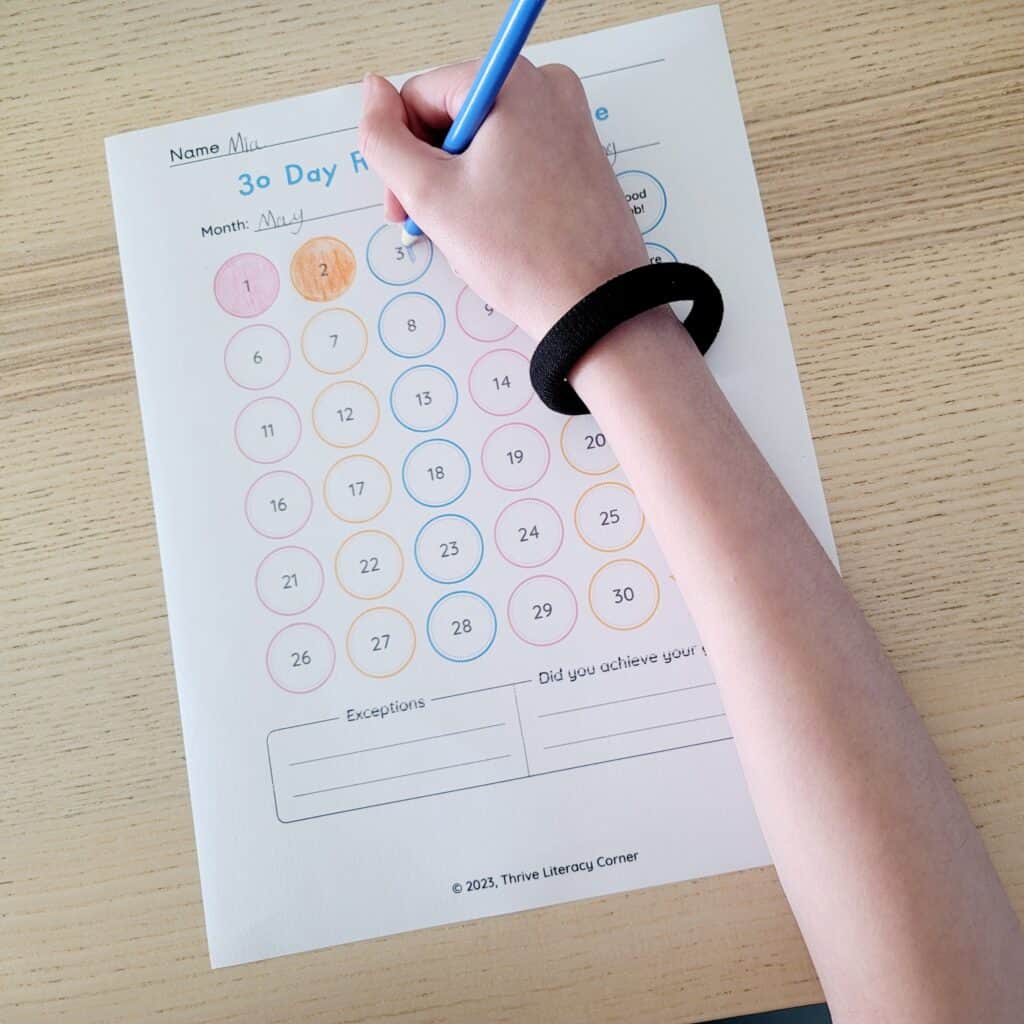Reading Logs: FREE Resources + Reading Log Alternatives
This post may contain affiliate links, and I will earn a commission if you purchase through these links. Please read the disclosure policy for more details.
Do you remember using reading logs as a kid? I remember having them throughout elementary and middle school.
And as a teacher, most schools have required me to assign reading logs to my students.
But as I have learned more about reading and best practices (based on research), I have learned that they are not always a good tool to use.
Read on to find out when reading logs are good to use, why using reading logs can be problematic, and what you can do instead. There are actually a few better alternatives that I started using in my final years in the classroom.
And if you’re looking for a free printable reading log, I have a few options available in my freebies library. Just sign up to my newsletter below to get access.
Grab FREE printable reading logs by subscribing to my list!
*Most school spam filters block my emails, so please use a personal email.

What Is a Reading Log?
A reading log is a simple yet effective tool that helps you keep track of your reading habits and progress. You can track books read, time read, and other details such as the author, genre, title, plot, and even your thoughts books.
This comes in handy, especially when you want to remember or recommend an interesting book to a friend. Reading logs are commonly used by both students and book enthusiasts alike.
Benefits of Using a Reading Log
For Students
Reading logs can help students develop their reading habit and improve their comprehension skills. Tracking reading progress may encourage them to read more and explore various genres. It comes in handy, especially for 1st and 2nd graders who need to practice their literacy skills. Rereading and logging details about what they’ve read enhances fluency and deepens their understanding of the text.
Moreover, if students are reflecting or answering questions in their reading log, it fosters critical thinking. By reflecting on what they’ve read, they can easily formulate connections and thoughts about the text. This practice helps them engage with the material, making reading enjoyable and interactive.
But for some students, reading logs can have negative impacts. More on that in the next section.
For Teachers
In the classroom, reading logs can help with monitoring your students’ reading progress. Tracking their preferences and habits gives you valuable insights into their interests and strengths. This information can help you tailor your teaching strategies to address individual needs effectively.
Additionally, reading logs can be used as a means to encourage collaboration and discussion among students. By asking them to share their thoughts on their readings, you can foster a positive reading culture and stimulate classroom discussions.

Why You Shouldn’t Use Reading Logs
Reading logs might seem like a useful tool to track your students’ progress and encourage them to read, but they can actually have some unintended negative consequences. Let’s explore a few reasons why you might want to consider ditching reading logs.
Decreased motivation: One study found that mandatory reading assignments, such as reading logs, can actually lower your students’ motivation to read. Instead of inspiring a love for reading, reading logs may turn reading into a chore that they’d rather avoid.
Tediousness: No matter the style of log you use, some students may find them to be dull and uninspired. While simple logs can be helpful for you to keep track of what students are reading, they may not be particularly engaging or motivating for the students themselves.
Time-consuming: Reading logs require both your time and your students’ time. Students must fill out their logs, and you must monitor and grade them. This can take away valuable time that could otherwise be spent on more meaningful reading activities or one-on-one discussions about the books they are reading.
Limited accountability: While reading logs might provide a record of what your students have read, they don’t always accurately reflect comprehension or genuine engagement with the material. Simply tracking the titles and pages read doesn’t necessarily ensure that students are truly understanding or enjoying the texts.
And often times, reading logs encourage lying. Students who struggle with reading may just fill out the logs even though they didn’t read anything.
Reading logs are not for everyone, but I have some other, even better options for you to use with your students.

When To Use Reading Logs
So if reading logs are not always ideal, when should we use them?
For students who enjoy using reading logs, or those who are more achievement oriented and organized, reading logs are a great option.
Reading logs can also be helpful if they contain a space to write down some thoughts or answer a question as a way to develop a deeper understanding of the text and better recall details later.
This would work well if you’re reading a book with your class but students have to do some of the reading on their own.
I would not recommend you use reading logs on a daily basis throughout the school year. Instead, choose a few periods throughout the year that you want to use them and keep it as minimal as possible. Don’t require that students track time read, but instead ask them to reflect on what they read that week. It should be as simple as one sentence so they don’t lose motivation.
Types of Reading Logs
Printable Reading Logs
Printable reading logs are a great way for both kids and adults to track their reading progress. These logs often come in a PDF format and can be filled out with pen or pencil. The printable reading log typically includes spaces for noting down the book title, author, pages read, and time spent reading. Some printables even have dedicated sections for different genres like non-fiction or horror.
Grab FREE printable reading logs by subscribing to my list!
*Most school spam filters block my emails, so please use a personal email.

Printable reading logs can provide a fun and engaging way for children to visually track the books they’ve read – that is, for kids who like to track their reading. For example, a popular layout for kids is the “bookshelf” style, where each book read is added to a printout of a bookshelf. This encourages children to fill their bookshelves with more reads. Other kids may like a challenge to read X number of books/pages in a given time.

Digital Reading Logs
In the age of technology, digital reading logs are becoming increasingly popular. These logs are compatible with various devices like laptops, tablets, and smartphones. Digital reading logs can be tailored to meet your specific needs, just like their printable counterparts.
You can make digital reading logs on Google Sheets, editable PDFs, a notes app on your device, or even specific websites like Goodreads.
Using digital reading logs helps you stay organized and maintain a more eco-friendly approach to tracking reading. It’s also convenient for on-the-go readers who don’t want to carry around physical materials like a pen and paper printable log.
Reading Log Alternatives
If you want to move away from reding logs, which is what I recommend, give one of these reading log alternatives a try:
Reading Response Journal
Instead of the traditional reading log, you could consider using a Reading Response Journal for your students. This allows them to write down their thoughts, questions, or connections while they read. Encourage them to express their feelings about the text, make predictions, and ask questions. By doing so, they will engage more meaningfully with the material.

Accountability Partners
Another option is to use accountability partners. Pair students together and assign them to be each other’s accountability partner. They can support and encourage one another to meet their reading goals throughout the week. This method not only fosters a sense of camaraderie, but also helps students develop a sense of responsibility and accountability for their own learning and the learning of others.
Peer Recommendations
Encourage your students to recommend books to others based on their interests. Sharing book reviews informally or through a class book recommendation board can be an effective way for students to share their reading experiences. Plus, it helps other students discover new books and broaden their reading horizons.
I have seen where other teachers have students write down the titles of books they love on sticky notes and put them in on a bulletin board to give other students ideas on new books.
Class Reading Meter
Create a visual class reading meter as a collaborative goal-setting tool. Divide the meter into increments and as students complete books, they can add their progress to the meter. This way, students can see the collective progress made by the class and celebrate their achievements together.
Reading Conferences
Holding individual reading conferences with your students can serve as a more personalized alternative to reading logs. By discussing their reading progress, preferences, and challenges, you can help them set realistic goals and develop strategies for overcoming obstacles. Regular check-ins can also help you monitor their progress and provide support as needed.
I find that students who struggle with reading do best with this approach. Just as long as they are reading a book that is at their level.

Conclusion
In conclusion, maintaining a reading log can be a valuable tool to enhance students’ reading experience and help them track their progress. By keeping a reading log, students are able to revisit the books they’ve read, reflect on their content, and gain a deeper understanding of the material.
If you’re looking for something more effective, consider one of the reading log alternatives such as reading response journals, accountability partners, or reading conferences.
Sources:
- Pak, S.S.; Weseley, A.J., The Effect of Mandatory Reading Logs on Children’s Motivation to Read. Journal of Research in Education, v22 n1 p251-265 Spring. 2012
- Deci, E. L., Koestner, R., & Ryan, R. M. (2001). Extrinsic Rewards and Intrinsic Motivation in Education: Reconsidered Once Again. Review of Educational Research, 71(1), 1–27. https://doi.org/10.3102/00346543071001001







